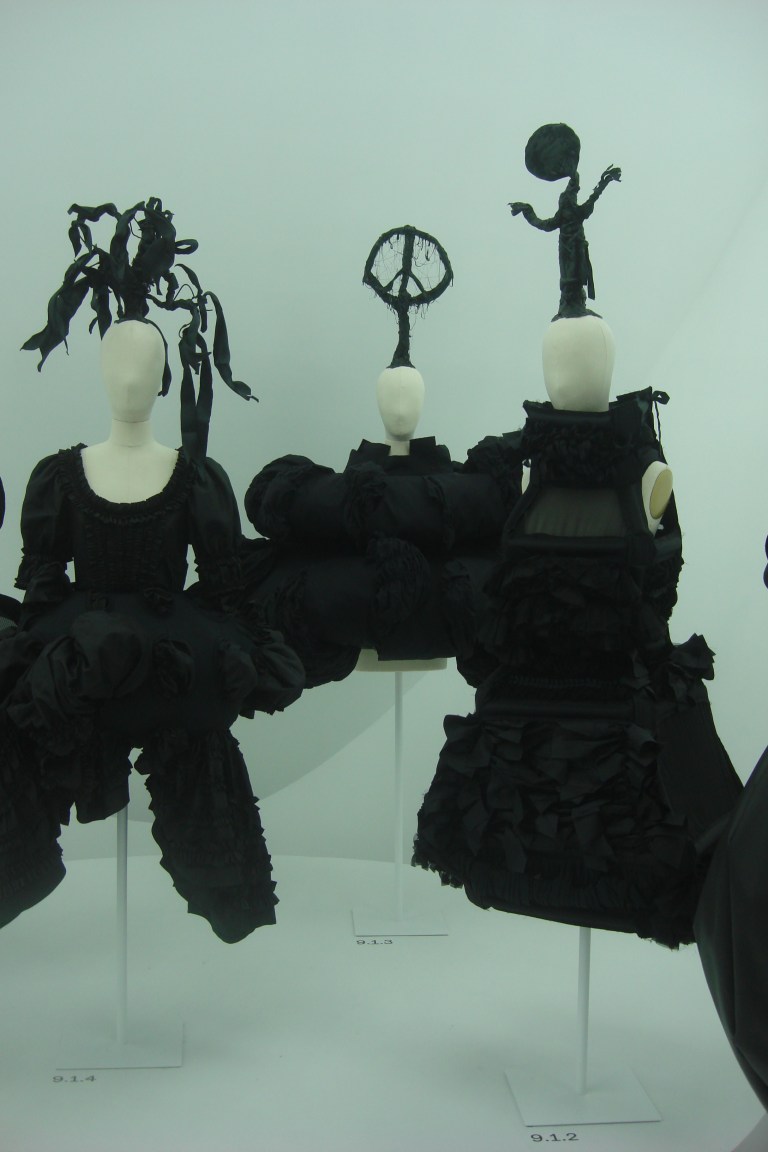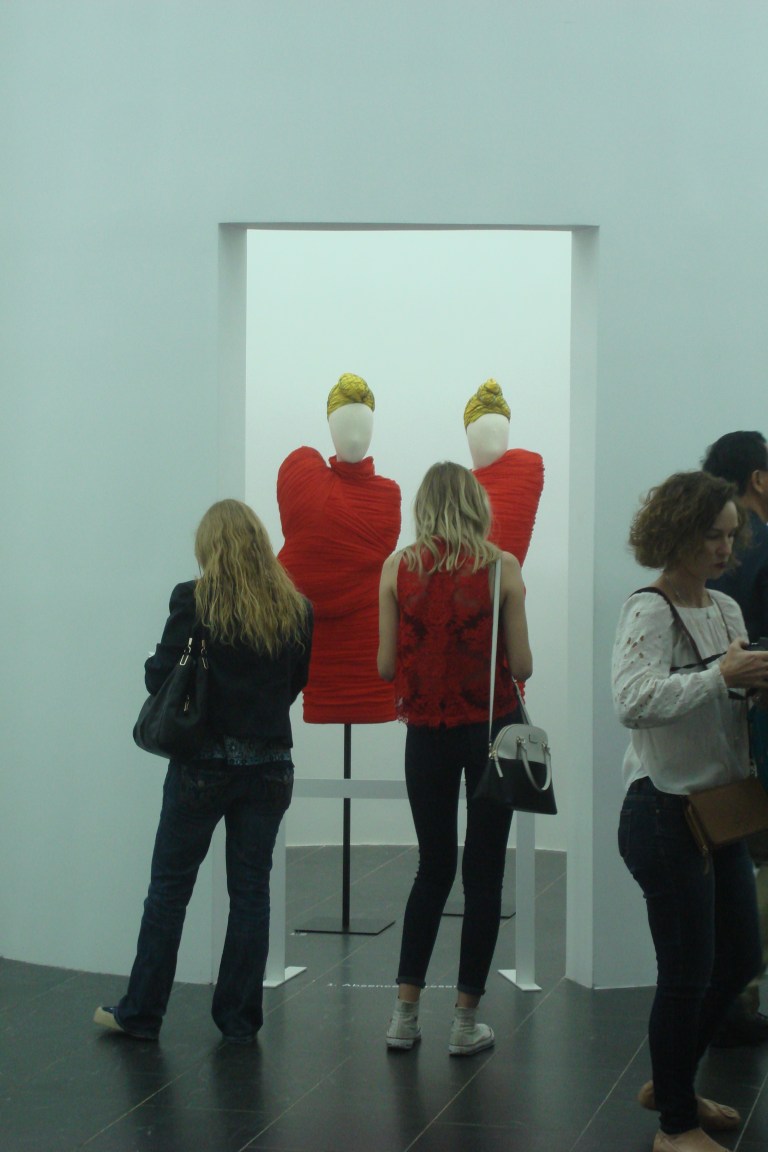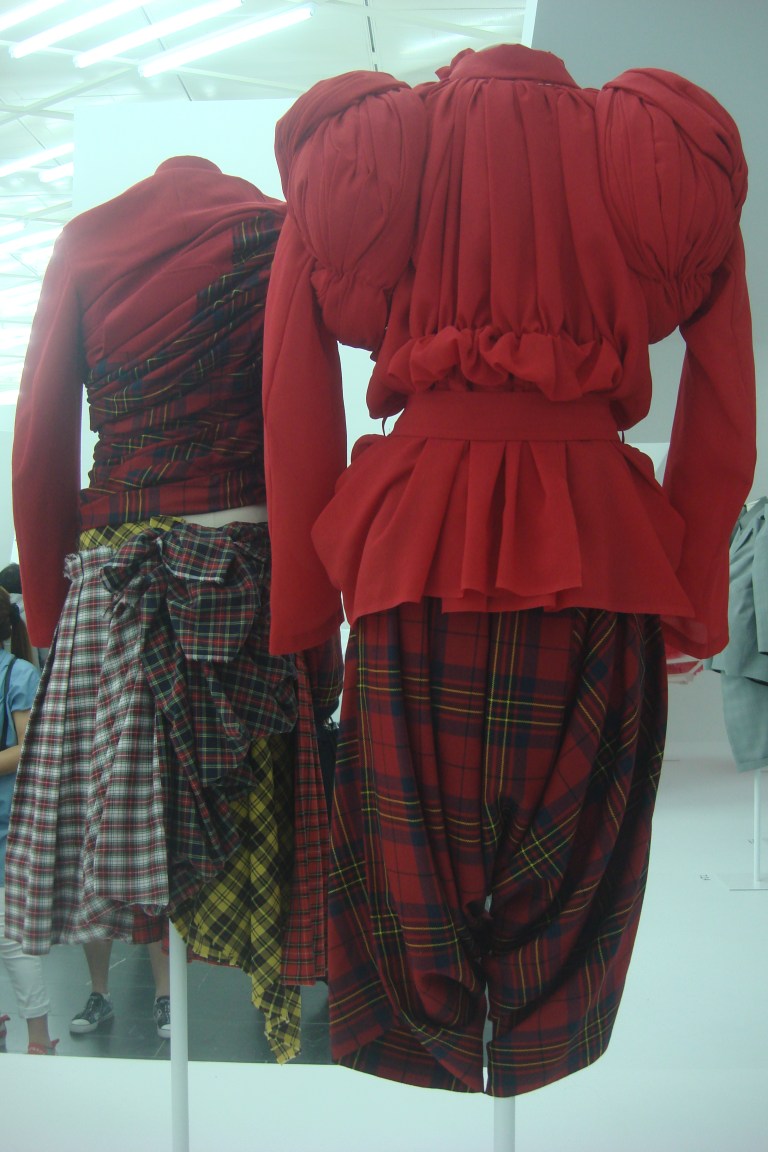Rei Kawakubo, born 1942, Japan
Comme des Garçons
label begun in 1969; company founded in 1973.
Art of the In-Between
A retrospective of the Costume Institute at Metropolitan Museum, NY, Summer 2017
These clothes from the 1980s to the present are of Rei Kawakubo’s earliest pieces which are wearable to her mid- and late work which are not wearable.
They are soft sculptures.

The Met rationalized the designer’s work.
They noted the designer’s aesthetic sensibility: unsettling, elusive and visually ambiguous. In between.

The Met noted the designer’s incorporation of aesthetic principles rooted in Buddhism:
fusion, imbalance, the unfinished, and design without design.

The Met noted the designer’s many interests:
in abstraction and in sculptural qualities; her dislike of the representational;
her indifference to accepted standards of beauty;
her fascination with the 19th century bustle;
her defiance of and frustration with the status quo and her wish to ‘engage with the zeitgeist…..symbolically and conceptually.
her early incorporation of ‘space’ and ’emptiness’; and of high’ (ballet) and ‘low’ (bikers) style and of punk.
Rei Kawakubo established Comme des Garçons in 1973 with, in her words, the sole aim of achieving personal autonomy.
She opened her first boutique in Tokyo in 1975 and the first in Paris in 1978.
“Independence has always been of the greatest importance to me,” she has said.
She wants to be free of the authorities over us and of the conventions which imprison us.
The designer said that she does not see herself as an intellectual but as someone who is expressing her feelings and fears.
She has said that she dispensed with
“all preconceived notions about Western and Eastern social mores and cultures, as all these things are irrelevant to my world”…..

This designer has gone further in this work: she has let go of the body as the constraining principle of her sculptural work which she calls her ‘clothes’.


Rei Kawakubo has also said that she does not care about function at all.

______________________________
The Met framed the exhibition in an all-white, sculptured space with clothing at ground level and above the heads of visitors.



Dead and uncomfortable spaces in this exhibition.
Lighting so loud that it was difficult to clearly see clothes not at ground level.

Little corridors going nowhere; blind, curved walls;
claustrophobic space around certain creations so that alarm bells were constantly trilling because visitors were overstepping the protective line;

All of this to reinforce the notion that Rei Kawakubo’s work is a disruption of conventional norms of beauty and fashionableness.
____________________________
Materials used in these creations included;
polyster felt, lycra, taffeta, rayon velvet, net, mesh, flannel, wadding, and organza;
polyurethane plain weave and tulle;
cotton knits, canvas, duck, poplin, lawn, lace, plain weave, twill and velveteen; brushed cotton, synthetic cotton lace;
silk satin, habotai, charmeuse, velvet, chiffon, knits and jersey;
wool jersey, mohair, twill, and knit jacquard; wool-nylon jersey and plain weave;
nylon tulle, stretch gingham; stretch nylon, chiffon and plain weave;
acrylic crochet, wool thread, felt, worsted and knit;
cupra organza, and cupra-rayon devore velvet;
linen;
glass beads; feathers; rubber; goose down; leather; tartan; elastic; PVC; elastic.
___________________
























Mention was made of the designer’s engagement with the Japanese notion of ‘cuteness’.

this photo from the web of the Metropolitan Museum


Comme des Garçons, founded 1959; ensemble of polyester, nylon, 2018. Included in the Kimono exhibition in 2022.
Rei Kawakubo, Japanese born 1942. Metropolitan Museum of Art, NY
















A woman said how often she had wished for a gown like this below – presented under a label ‘Life/Loss” – and for the time to sit, immobile, wearing it.
















































Rei Kawakubo is a foremost member of the haute couture community in which she has been very successful. A community with discipline and constraints, rules, rigid schedules; and a dark underbelly.
She has made herself an alternate world for her independent creativity: a world in which she need not be concerned with the ‘real world’.

Perhaps she would have been gratified at the appreciation of many women circulating through this exhibition: recognition and appreciation.

Here is an aesthetic in which shape and size are given the large imaginative leeway that is almost always missing in the display of the work of haute couture fashion designers.

A freedom of size and of shape which, in the real world, are controlled by social conventions
with the consequence that large numbers of ‘Western’ women suffer from one form or other of body dysphoria, body anxiety, and life-long dieting and all kinds of cosmetic surgery.
Which is why so many women smiled all the way through this exhibition…

Rei Kawakubo’s most recent work, the Met described as a ‘transgressive’ fusing of body and cloth’.
No more couture.
As though the designer had freed herself altogether from the profession which sustains and constrains her.



The appreciation of these creations was not uniformly shared.
Here a comment by two young visitors to the exhibition. But, of course, they are still slim and lithe and young and insouciant.
_____________________


Ce sont des œuvres d’art c’est certain mais qualifier ça de “vêtements” est un abus de langage;
C’est importable.
C’est un avis que je partage. Sarah
Really interesting and fascinating
Thank you for your comment. I think she is a brave one! Sarah